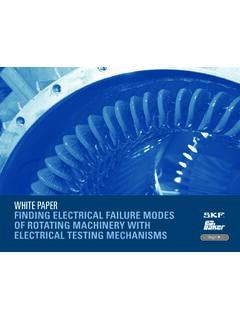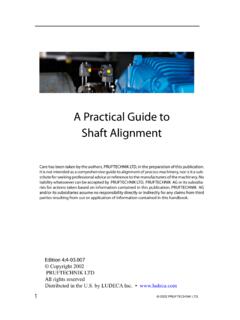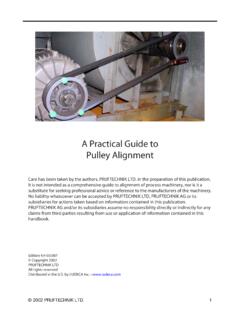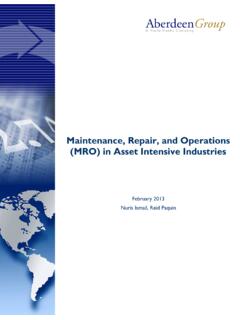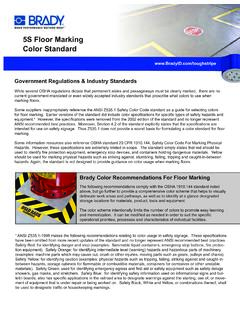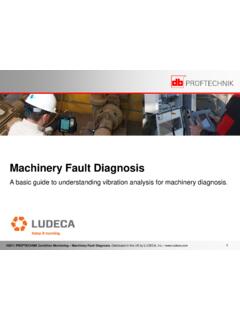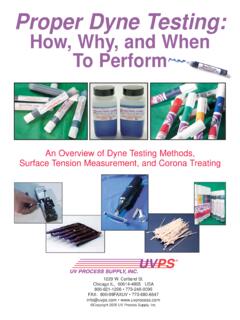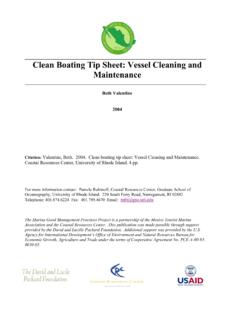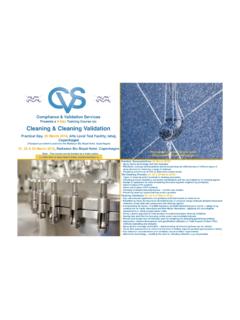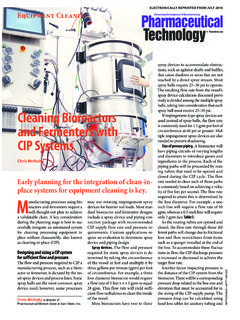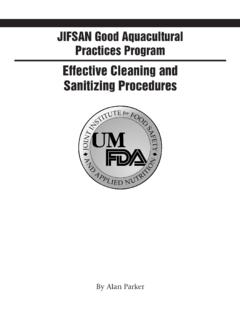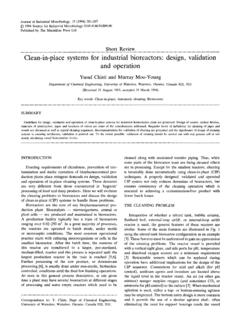Transcription of A Guide to Tank Cleaning Automation - Plant …
1 A Guide to Tank Cleaning AutomationChristine Pagcatipunan, Spraying Systems the Cleaning of tanks , totes, vats, vessels or anyother type of container offers many benefits. Typically, the top reason to automate is to improve Cleaning , the reduction of maintenance time/productiondowntime is also a compelling and motivating factor. Othercommon reasons include improving worker safety, reducingconsumption of expensive Cleaning chemicals/solvents andlowering wastewater disposal costs. Proper selection of a tank Cleaning solution requires collaboration between process Plant personnel and the tank wash equipment manufacturer. Cleaning objectives are specific to a manufacturing process and should be established by Plant personnel. A variety of options are available tank wash nozzles for clean-in-place (CIP),motorized tank washers, fluid-driven (turbine) tank cleaningmachines and turnkey systems offering complete Automation and it is essential to consider your short- and long-termneeds to ensure you make the right buying decision.
2 The discussion within addresses the following: Cleaning Criteria What is the residue to be cleaned? What Cleaning is required to remove the residue? What is the temperature of the Cleaning liquid? What is the reason for Cleaning ? What level of Cleaning is required? What flow design is used? What are the dimensions of the tank? Are there obstructions within the tank? How many tanks need to be cleaned? How often do they need to be cleaned? What is the size of the porthole and where is it located? What equipment is available?Understanding the Available OptionsSpray technology fundamentals and effect on Cleaning efficiency: Flow design Flow rate spray pattern spray coverage Shadowing spray distance spray impact Cycle timeUnderstanding Possible Solutions Clean-In-Place (CIP) nozzles/systems CIP or portable motorized and fluid-driven (turbine) tank washers Automated tank Cleaning systemsFinal Product Selection Identifying the option that best meets Cleaning objectives Determining materials of construction Installation considerations: CIP, portable, physical layout Experts in spray TechnologySprayNozzlesSprayControlSprayA nalysisSprayFabricationA Guide to Tank Cleaning AutomationIntroductionProcess improvement and cost reduction are key motivatorsfor any Plant .
3 As a result, automated tank Cleaning is increasing in popularity. A change in tank Cleaning methodscan result in dramatic increases in production uptime, areduction in the amount of labor required for Cleaning andcost savings on water, Cleaning chemicals, energy andwastewater disposal. There are other benefits as well improved worker safety and elimination of the need for vessel Entry Permits required by OSHA. Nearly all totes, tanks , vessels and vats contain productresidue that must be removed between batches or at routineintervals in continuous operations. Historically, two methods have been used for tank Cleaning :1 The Manual MethodA worker physically cleans a tank and may actually enterthe tank. This raises safety concerns about tank entry/exitand exposure to toxic fumes from Cleaning agents. TheManual Method often results in inconsistent Cleaning andthe use of more Cleaning chemicals and water than isreally necessary. 2 The Fill and Drain MethodTanks are usually hosed down and then filled with hotwater or a mix of water and Cleaning /sanitizing tank may be drained and rinsed several times before use.
4 This method is time-consuming and utilizes significant amounts of water, Cleaning chemicalsand energy. It also can keep a tank out of production for several plants find they can save tens of thousands of dollarsannually by automating their tank Cleaning with several tanks have reported savings of more than $100,000 per if you could benefit similarly through Automation begins with a close look at your Cleaning objectives. Establishing Cleaning ObjectivesThe primary objective of any tank Cleaning project is to clean, maintain and sanitize equipment at appropriate levelsto prevent malfunctions or contamination that would alter the safety, identity, strength, quality or purity of the finishedproduct. Each tank Cleaning application is unique and findingthe best automated solution requires a collaborative effortbetween process Plant personnel and the tank wash equipment manufacturer. 1 The first step in setting objectives requires an evaluation of the product residue to be cleaned.
5 A product residue is defined as any material left behindwhich should be washed away before another batch ofproduct arrives. Residue can come in different forms Residue that does not stick to the surface and can therefore be cleaned easily Residue that does not wash away quickly but can be dissolved by the Cleaning liquid Residue that does not dissolve by the Cleaning liquid but relies heavily on the spray impact to break it up and wash it away2 The second step is to identify a Cleaning liquid. The Cleaning liquid will react with the product residue to physically wash it away or dissolve it. Once you veidentified the Cleaning liquid, you need to consider its temperature and material compatibility. This will be important when selecting the tank wash nozzles/systemfor your third step is to determine what level of Cleaning is required:What level of Cleaning is requiredRinsingRemoves the majority of product residue with waterCleaningLoosens and removes product residue by means of water and a Cleaning agentSanitizingIncludes the application of sanitizing agents to all surfaces (per chemical supplier instructions).
6 Micro-organisms are killed to an acceptable levelDisinfectingKills 100% of most bacteria, not sporesSterilizingDestroys or eliminates all forms of lifeOnce you ve established your Cleaning objectives what you need to clean, what you are going to use to clean it and the required Cleaning level it is time to focus on tank washing technology so you understand how to evaluate your Guide to Tank Cleaning AutomationAutomated Tank Washing: spray Technology Fundamentals Flow DesignThere are two forms of system flow design:1 Total loss flow designis when the Cleaning liquid is used once and then discharged. This design is only applicable when cleaningis infrequent or very small volumes of liquid are loss flow design is advantageous because it prevents cross contamination from Cleaning liquids. 2 Partial or total recovery flow designis when the final rinse liquid is recovered and a watermake-up rate is determined for reuse. A recirculatedcleaning system will be more contaminated than the totalloss flow design.
7 However, a partial or total recovery flowsystem uses less chemicals and water than a total lossflow system. The water supply needs to be evaluated for any potential problems, such as dissolved solids orsuspended particulate, which may interfere with thecleaning process. Use the appropriate strainer and mesh. Flow RateUse the lowest flow rate possible to achieve your cleaningobjectives. The lower the flow, the less liquid required, lesseffluent for disposal and less energy consumed. If you re not sure how much flow is required, a general guideline is to work with a minimum of gal/min/ft2(7 l/min/m2) of vessel internal surface area. A more moderaterecommendation is gal/min/ft2(15 l/min/m2). This guidelineapplies generally to stationary nozzles where all the surfacesof the tank are sprayed at the same time. Nozzles that rotateusually contact part of the tank at one time. Less flow rate isneeded. Refer to published tank diameters and testing todetermine the correct flow rate for rotating nozzles.
8 spray PatternMost spray balls and tank wash nozzles generate a solidstream, flat fan or full cone spray . Your Cleaning requirementswill determine the pattern you need. In general, under equaloperating conditions, solid stream sprays provide the greatestimpact, followed by flat fan and full cone , fixed spray nozzles with full cone sprays are usedfor gentle rinsing and washing. Fluid-driven nozzles with flatfan sprays offer more impact and are commonly used forcleaning. High-pressure motor-driven and fluid-driven (turbine) nozzles use solid streams for maximum impact. Solid Stream: This pattern is created whenliquid leaves a round orificein a circular pattern. Flat spray :This pattern is producedwhen a solid stream exits an elliptical orificeforming a thin elliptical cat s eye cone:An internal vane in the fullcone nozzle causes some ofthe entering liquid to swirland mix with non-spinningliquid. The mixed liquid exits the orifice in a conical CoverageTypical coverages include 180 up, 180 down, 270 up, 270 down and 360.
9 Again, you want to use the least amount ofcoverage required to achieve your Cleaning objectives andeliminate unnecessary water usage and wastewater Coverage180 up180 down270 up270 down360 A Guide to Tank Cleaning AutomationAutomated Tank Washing: spray Technology Fundamentals ShadowingWhen a spray cannot directly reach part of the vessel because of an internal obstruction, it is called shadowing. This obstruction can be a mixer, agitator or filling tube for example. The problem is to clean both the shadowed area and the obstruction itself. In cases where one nozzle cannot cover the entire internal surface, multiple nozzles are DistanceSpray distance, sometimes referred to as throw , is definedas the distance between the spray exiting the nozzle orifice tothe spray hitting the target surface. The spray coming fromthe nozzle should extend to reach the walls of the tank because the spray reaches the tank surface, does notmean it can clean the heavily soiled areas.
10 The spray losesimpact the farther away it gets from the nozzle. Adequatepressure should be supplied to the nozzle so the Cleaning liquid will be sprayed with enough impact and spray distance. Most nozzle manufacturers will specify the diameter of a tankvessel that the spray will reach to effectively clean the tankinternal surface. However, it is important to take the tanklength into account as well. If you have a tank that has a 20' (6 m) diameter and 40' (12 m) length, you should not use atank washer that only specifies a tank diameter of 20' (6 m).You will need to use two tank washers that specify 20' (6 m)or a different tank washer that can clean up to 40' (12 m). spray ImpactHow much impact is required depends on a variety of factors the residue, the Cleaning chemicals, the watertemperature and more. Hard-to-clean residues require ahigher level of impact than residues that are easily rinsed. The theoretical spray impact can be obtained from the following equation:I = K x Q x PwhereI:Total theoretical spray impactK:ConstantQ:Flow rateP:Liquid pressureFor any given nozzle, this is the total impact, neglecting alllosses that an equivalent solid stream nozzle would havewhen operating at the same pressure and with the same flow as the given of flow rate on impact:Using the equation above, it can be concluded that increasingflow rate is more effective than increasing pressure.
